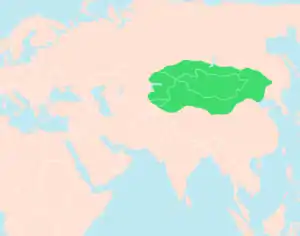Huyandi
Huyandi (Chinese: 壺衍鞮) was the son and successor of Hulugu Chanyu. He ruled as the Chanyu of the Xiongnu Empire from 85 to 68 BC.[1]
| Huyandi | |
|---|---|
| Huyandi Chanyu | |
 Domain and influence of the Eastern Huns | |
| Reign | c. 85–68 BC |
| Predecessor | Hulugu Chanyu |
| Successor | Xulüquanqu Chanyu |
| Dynasty | Modu Chanyu |
| Father | Hulugu Chanyu |
| Mother | Zhuanqu Yanzhi |
Huyandi was not first in the line of succession and only became chanyu due to a plot by his mother Zhuanqu Yanzhi and the Han defector Wei Lü. He came to power in 85 BC.[2]
In 71 BC, Chang Hui and two other generals led a force of 100,000 to aid the Wusun against the Xiongnu. The majority of the forces failed to find any Xiongnu, but Chang Hui successfully aided the Wusun in defeating a Xiongnu invasion. However the Xiongnu came back in winter and took many captives. On the way back across the Altai Mountains, the Xiongnu suffered heavy casualties from a sudden blizzard, devastating their army. The next year the Xiongnu were attacked on all sides by Wusun, Wuhuan, and the Han. One third of all Xiongnu died.[3]
Huyandi died in 68 BC and was succeeded by his brother, Xulüquanqu.[1]
Footnotes
- Loewe 2000, p. 629.
- Loewe 2000, p. 178.
- Whiting 2002, p. 174.
References
- Bichurin N.Ya., "Collection of information on peoples in Central Asia in ancient times", vol. 1, Sankt Petersburg, 1851, reprint Moscow-Leningrad, 1950
- Chang, Chun-shu (2007), The Rise of the Chinese Empire 1, The University of Michigan Press
- Cosmo, Nicola Di (2002), Ancient China and Its Enemies, Cambridge University Press
- Cosmo, Nicola di (2009), Military Culture in Imperial China, Harvard University Press
- Loewe, Michael (2000), A Biographical Dictionary of the Qin, Former Han, and Xin Periods, Brill
- Taskin B.S., "Materials on Sünnu history", Science, Moscow, 1968, p. 31 (In Russian)
- Whiting, Marvin C. (2002), Imperial Chinese Military History, Writers Club Press
| Preceded by Hulugu |
Chanyu of the Xiongnu Empire 85–68 BC |
Succeeded by Xulüquanqu |